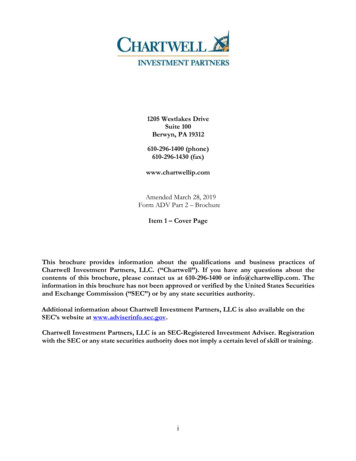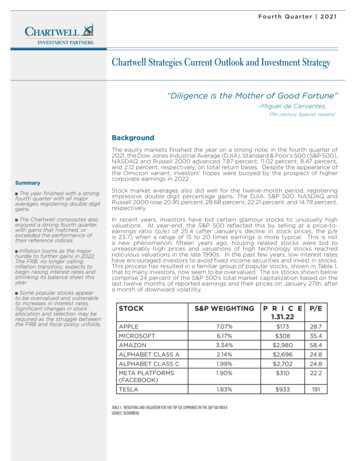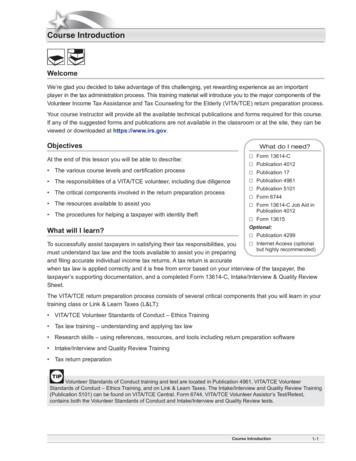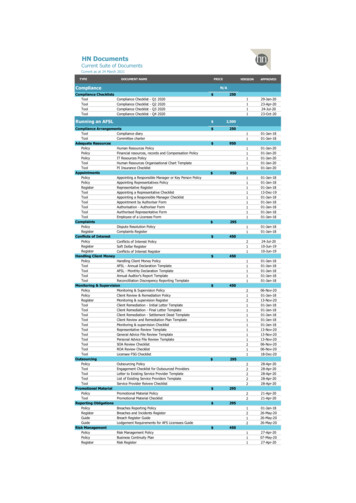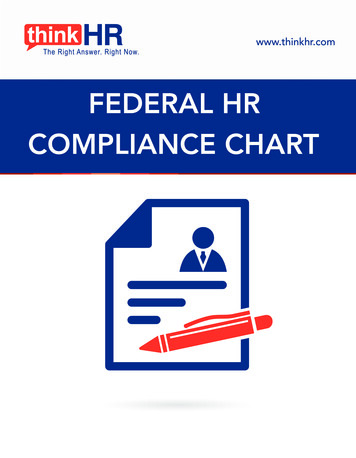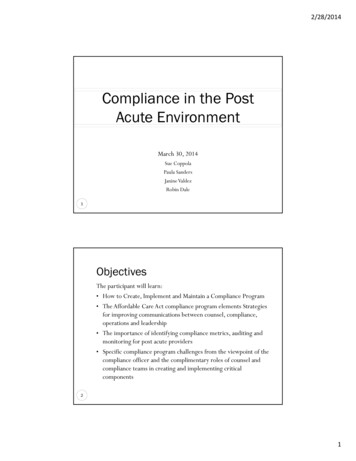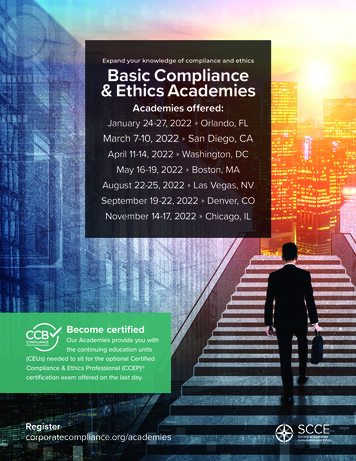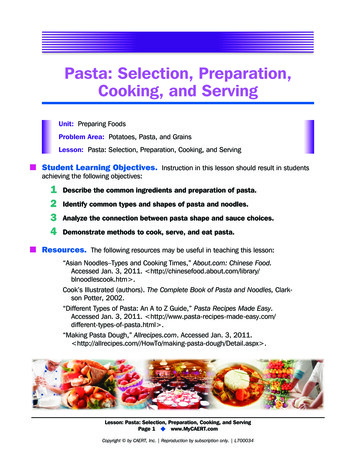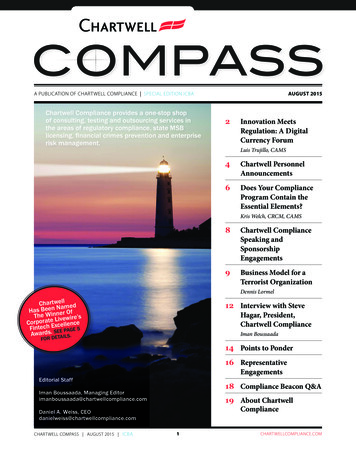
Transcription
A PUBLICATION OF CHARTWELL COMPLIANCE SPECIAL EDITION ICBAChartwell Compliance provides a one-stop shopof consulting, testing and outsourcing services inthe areas of regulatory compliance, state MSBlicensing, financial crimes prevention and enterpriserisk management.AUGUST 2015 2Innovation MeetsRegulation: A DigitalCurrency ForumLuis Trujillo, CAMS4Chartwell PersonnelAnnouncements6Does Your ComplianceProgram Contain theEssential Elements?Kris Welch, CRCM, CAMS8Chartwell ComplianceSpeaking andSponsorshipEngagements9Business Model for aTerrorist OrganizationDennis LormelChartwellmedn NaHas Beeinr OfThe W niveewire’sLCorporateExcellenceFintech SEE PAGE 5Awards. TAILS.12 Interview with SteveHagar, President,Chartwell ComplianceIman BoussaadaFOR DE14 Points to Ponder16 RepresentativeEngagementsEditorial Staff18 Compliance Beacon Q&AIman Boussaada, Managing Editorimanboussaada@chartwellcompliance.com19 About ChartwellComplianceDaniel A. Weiss, CEOdanielweiss@chartwellcompliance.comCHARTWELL COMPASS AUGUST 2015 ICBA1CHARTWELLCOMPLIANCE.COM
Innovation Meets Regulation:A Digital Currency ForumBy Luis Trujillo, CAMSWhen it comes to currency, the terms“digital” and “virtual” are often thoughtto be one in the same. This commonschool of thought is a misunderstanding that even I am guilty of at times.Digital currencies are defined as currencies that are stored and transferredelectronically. Digital currencies havebeen around for decades and may bebacked by real money or forms of valuethat are physically stored somewhere,such as real tender money, preciousmetals such as gold and silver, or anyphysical or real item to which we maydesignate a value.Virtual currencies are common todigital currencies in that they may bestored and transferred electronically.But in contrast to normal digital currencies, they are a form of digital currency that is not backed by real physical forms of value. They are not basedon physical reality. They are stored asinformation in a virtual world, and wedesignate the value to them. Virtualcurrencies have been around for manyyears in the gaming industry, but innovation over the past few years haveincreased global consumer adoptionin the use of crypto-currencies, whichcarries us into a conversation about Bitcoin.In 2007, it became public that ananonymous person, or perhaps a groupof people, known as Satoshi Nakamoto(“Satoshi”) were working on a projectto create a peer to peer electronic currency network. In October 2008, Satoshi published what is known as “TheWhite Paper”, providing a descriptionof the Bitcoin currency and provides asolution to “double spending”, meaninga solution that does not allow the electronic currency to be copied. In 2009,the first version of the Bitcoin protocolwas released to the public and the restCHARTWELL COMPASS AUGUST 2015 ICBA2is history. After many downfalls andbumps along the road, the protocol wasupdated, reconfigured and mysteriousoperations to the likes of the Mt.Goxand Silk Road scandals began to dwindle.We’re now six years removed from itscreation, and the adoption and innovation of Bitcoin continues to grow. But,is Bitcoin the relevant subject in all ofthis? The answer is no. The most important innovation in all of this is the technology of the blockchain. The blockchain is the engine that runs the Bitcoinprotocol. Bitcoin is merely a currency.The blockchain is what powers the instant and free transfer of value and information. That’s right, the blockchaintechnology is capable of processing,recording and transferring any type ofinformation, not just Bitcoin, but that’sfor another article in and of itself.All the developments discussed herein, have enabled the evolution of Financial Technology (“Fintech”) to anotherlevel. Fintech enterprises have been ableto develop instant, low cost – sometimes even free – and secure financialservices for businesses and consumersby integrating digital currencies, virtualcurrencies or a combination of both.Much innovation continues to occuraround digital and virtual currencies asconsumer adoption continues to grow.Due to risks inherent to the industry,regulators have had no option but toreact. The Financial Crimes Enforcement Network (“FinCEN”) acted firstand the states are starting to follow.On March 18, 2013 FinCEN issuedits initial guidance on virtual currencies and regulatory responsibilities.This guidance defines the different parties in a virtual currency transactionand requires all parties that meet thedefinition of an administrator or exchanger of virtual currency to registerwith FinCEN as a Money Services Business (“MSB”), specifically as a MoneyTransmitter. The products and servicesprovided by the administrator or exchanger of digital or virtual currencyvary from one company to another. Ifthe administrator or exchanger alsoholds real currencies as stored value inCHARTWELLCOMPLIANCE.COM
1010.410(f)).” (U.S. Dept. of Treasury,2014).Even after the release of FIN2014-R012, there has been speculationon the applicability of all the aboveregulations on the industry, given thevirtual currency industry’s current inherent inability to fully comply withthe recordkeeping requirements ofthe “Funds Travel Rule”. Though, thisspeculation or “doubt” around havingto fully comply with the “Funds TravelRule” and all requirements of the BSAhave been settled by recent enforcement actions that address this matter.While FinCEN’s requirements foradministrators and exchangers of digital or virtual currency are starting tobecome clear, a “grey area” in compliance and regulations is still present asthe industry continues to wait for:Are digitaland virtualcurrencies andthe blockchainreally going tore-shape the waywe move money,value and allthe informationrelated to it? Asinnovation meetsregulation, wecan only waitand see.the forms of pre-funded e-wallets, thecompany may also be required to register as a Provider of Prepaid Access andcomply with all the requirements of therule.In response to an industry requestfor administrative ruling on the application of FinCEN’s regulations to a virtual currency payment system, FinCENfollowed its initial guidance with therelease of the FinCEN AdministrativeRuling FIN-2014-R012 on October 27,2014.Per FIN-2014-R012, any virtual currency administrator or exchanger registered as a money transmitter is requiredto: “(a) register with FinCEN, (b) conduct a comprehensive risk assessmentof its exposure to money laundering, (c)implement an Anti-Money Laundering1. Guidance from the Office ofForeign Assets Control (“OFAC”)when it comes to anonymous beneficiaries of certain transactionsProgram based on such risk assessment,and (d) comply with the recordkeeping,reporting and transaction monitoringobligations set forth in Parts 1010 and1022 of 31 CFR Chapter X. Examplesof such requirements include: the filing of Currency Transaction Reports,Suspicious Activity Reports (31 CFR §1022.320), whenever applicable, general recordkeeping maintenance (31 CFR§ 1010.410), and recordkeeping relatedto the sale of negotiable instruments(31 CFR § 1010.415). Furthermore, tothe extent that any of the Company’stransactions constitute a “transmittal offunds” (31 CFR § 1010.100(ddd)) underFinCEN’s regulations, then the Company must also comply with the “FundsTransfer Rule” (31 CFR § 1010.410(e))and the “Funds Travel Rule” (31 CFR §2. State regulators to proactivelyadopt and accept as a permissibleinvestment the form of valuedesignated for a digital currency,such as gold, and virtual currency,such as Bitcoin.What will the digital and virtual currency landscape look like in five years?Will the industry be able to adapt withimpending regulations? Will regulations be structured in a way that allowvirtual currency money transmittersto comply with the requirements? Aredigital and virtual currencies and theblockchain really going to re-shape theway we move money, value and all theinformation related to it? As innovation meets regulation, we can only waitand see.Luis Trujillo, CAMS, is a Compliance Director at Chartwell Compliance. He is a recognized former money transmitterstate regulator, former member of the Money Transmitter Regulators Association (MTRA) and experienced working withthe Financial Crimes Enforcement Network (FinCEN). He is a subject matter expert on the operations of moneytransmitters and financial technology enterprises. For more information please contact Luis at luistrujillo@chartwellcompliance.com.CHARTWELL COMPASS AUGUST 2015 ICBA3CHARTWELLCOMPLIANCE.COM
Chartwell Personnel AnnouncementsDAPHNE HOOVER joins Chartwell as InformationSecurity and Business Continuity Director. Daphne willhelp ensure Chartwell and its customers have best inclass information security and business continuity plansand controls in place. She is a 20-year Air Force veteranwith a background in Information Security. During hertime in the Air Force, Daphne worked in several differentareas of security from training other members inCommunication Security to inspecting CommunicationSecurity programs for National Security Compliance. Sheis currently working towards her Certified InformationSecurity Auditor (CISA) certification.SHERRY TOMAC joins Chartwell as a ProjectManagement Executive and Kaizen Manager. Sherry willserve as a trainer and mentor to our entire staff onproject management while helping oversee theday-to-day execution of kaizen continuousimprovement practices in Chartwell. Prior to joiningChartwell, Sherry was the Senior Director of Operations,Strategic Project Management at Western Union and theSenior Director of Operations at First Data. She waspreviously an auditor at Ernst and Young. Sherry is aCertified Six Sigma Black Belt, has expertise in lean andkaizen, and was even a kaizen sensei in a recent job.CRAIG MITCHELL joins Chartwell as a SeniorEnterprise Solutions Architect. Craig will be responsiblefor developing technology solutions to automatelabor-intensive manual processes for our customers andto make Chartwell’s internal operations more efficient.Craig is a 17-year veteran of First Data and WesternUnion, where he was a systems architect andprogrammer. At First Data, Craig designed andimplemented principle project tracking systems used by25 separate implementation teams, which helpedimprove service level agreement efficiencies,communication, accuracy, reporting and tracking.BRANDI REYNOLDS, CAMS, joins Chartwell as SeniorCompliance Professional. She will be an importantcontributor to our compliance and licensingengagements. Brandi previously worked at AdvanceAmerica for over 11 years where she managed AML andconsumer compliance. Brandi is CAMS certified, andreceived her Bachelors degree in BusinessAdministration and Management from LimestoneCollege. She holds national titles in Brazilian Jiu-Jitsu, is astudent pilot and enjoys most obstacle course races.CHARTWELL COMPASS AUGUST 2015 ICBA4Chartwell would like to congratulateCompliance Director, Trish Lagodzinskiand Operations Director, Lily Sayers oncompleting their Project ManagementCertificates at Penn State University andColorado State University, respectively.This one-year of classroom training willenhance Chartwell’s ability to providefirst class project management to ourcustomers and our own employees.Chartwell sponsored 100% of thetraining costs and is dedicated toemployee development and supportingthe goals of its team members.Way to go, Trish and Lily!Corporate Video on ChartwellCompliance Chartwell’s CEO, DanielWeiss, discussed Chartwell’s corporateculture and building a culture ofintention in our recent video. Thevideo was made in connection withthe company being recognized bythe Helios HR Apollo Awards, whichhighlight organizations that haveoutstanding employee developmentand engagement initiatives.See the video in our website.CHARTWELLCOMPLIANCE.COM
Chartwell Personnel AnnouncementsChartwell Conducts Leadership TrainingOn the Gettysburg BattlefieldEight future leaders from Chartwell took to the field by horseback and footfor the company’s annual leadership development training at the GettysburgCivil War battlefield. The two-day program was led by Colonel Tom Vossler,a 30-year veteran of the U.S. Army, and joined by a former Superintendentof Gettysburg National Military Park, John Latschar. The training followeda U.S. Army “staff ride” format of experiential learning, which draws on allparticipants to critically analyze situations and decisions on the battlefield.The group translated what it learned into how we can become better leadersfor our business and our customers. We explored issues such as decisionmaking under duress or fogs of war; taking self-initiative and risks; communicating vision and intentions; coordinatingefforts; managing supply chains; showing good character; and other themes.Chartwell Travels To Japan For Immersion TrainingIn Kaizen Continuous Improvement PracticesChartwell is constantly making efforts to improve the quality and efficiencyof the company as a whole, and to empower its employees to improve ourwork environment. For this purpose, seven Chartwell employees from seniormanagement, consulting and operations traveled to Japan for nine days in late Julyto be immersed in Kaizen continuous improvement training. When not in full-daysimulation exercises and workshops, our team toured Toyota, Yanmar and othermanufacturing facilities to learn from the world’s best implementers of the Kaizentotal quality control business philosophy. Kaizen experts, including the formergeneral manager of Toyota’s most successful production facility, led our training.Going forward, we have adopted the principles of Kaizen as an integral part ofour corporate ethos to be able to provide sustained excellence to our customers,partners and employees. We have scheduled a series of planning sessions andKaizen trainings for the year ahead, including a follow-up immersion in Japan, andhired both a Kaizen manager and systems automation architect out of First Data.CHARTWELL NAMED FINALIST AND WINNERChartwell Has Been Named The Winner Of CorporateLivewire’s Fintech Excellence Awards For Excellence InRegulatory Compliance & Risk ManagementThe Corporate LiveWire Awards is aninternational awards program recognizingstandout companies within the FinTechsector. These awards take an in-depthlook at the growing FinTech sector tocelebrate and reward companies that demonstrate industry leading innovationand excellence. Chartwell was selected as a winner for serving as a unique enablerfor payments organizations seeking to enter the American market and navigate itsregulatory hall of mirrors.CHARTWELL COMPASS AUGUST 2015 ICBA5The 2015 Healthiest Company AwardsChartwell has beennamed a finalist forSmartCEO’s HealthiestCompany Awards.Selected from apool of nearly 50nominees, Chartwell is one of five finalists in the 1-49employees category. The Healthiest Company Awardsprogram honors companies that have demonstrated acommitment to their employee populations throughhealth and wellness programs.CHARTWELLCOMPLIANCE.COM
Does YourComplianceProgramContain theEssential FiveElements?By Kris Welch, CRCM, CAMSThe five elements are: Leadership Risk Assessment Standards and Controls Training and Communications OversightLeadershipThis point means more than the “Toneat-the-Top; a successful complianceprogram must be built on a solid foundation of ethics that are fully and openly endorsed by the company’s seniormanagement. Management’s commitment to compliance should be unambiguous, visible and active. Even moreimportant than support or the righttone, compliance standards requirecompanies to have a high-rankingcompliance officer with the authorityand resources to manage the programon a day-to-day basis. The complianceofficer must also have unrestricted access and a direct reporting line to thoseresponsible for the corporate conduct,including the board of directors.Valuable questions regarding theleadership of a compliance programare: How is board oversight implemented? Does the company have anethics or audit committee reporting tothe full board? What is the role of theChief Compliance Officer? What is therole of the company’s General Counsel?How do the legal and compliance departments interact? Does the ChiefCompliance Officer have “real power”?The Board of Directors equally, has akey role to fulfill. The Board must ensure compliance policies, systems andprocedures are in place. The board isalso responsible for providing the resources needed to effectively implement the compliance program. Additionally, the Board should monitor theimplementation and effectiveness ofthe compliance program by: Being actively involved; Attending Board meetings; Reviewing, considering andevaluating the informationprovided; Inquiring further when presentedwith potential issues or questionablecircumstances; As soon as the Board is aware, itshould act on potential complianceissues; and Regularly receiving complianceCHARTWELL COMPASS AUGUST 2015 ICBAbriefings and trainings6Risk AssessmentThe implementation of an effectivecompliance program is more than simply following a set of compliance regulations or providing effective training.Compliance issues touch many areasof the company and you need to know:not only what your highest risks are,but where to focus your efforts to mitigate them and move forward. A riskassessment is designed to provide a bigpicture of your overall compliance obligations and then identify the areas ofhigh risk in order to prioritize and allocate your resources to the appropriateareas first.What are some of the areas whereyou need to assess your risks? Products and services; Customers and entities; Geographic Locations; Business Opportunities andPartnerships; and Transaction RiskIn addition to an initial risk assessment used to either: (1) develop yourcompliance program, or (2) help youidentify high risks and prioritize theirCHARTWELLCOMPLIANCE.COM
It is important to pay attention towhat employees say during training.This is because training can alert you topotential problems based on the typesof questions employees ask and theirlevel of receptiveness to certain concepts.Oversightremediation, risk assessments shouldbe a regular, systemic part of the compliance efforts rather than an occasional ad hoc effort exercised when convenient or after a crisis has occurred. It isrecommended the risk assessments beprepared close to the same time eachyear or prior to when new products orservices are introduced. Annual riskassessments act as a strong preventivemeasure if they are performed beforesomething goes wrong and help youavoid a “wait and see” approach.Standards and ControlsGenerally, every company has threelevels of standards and controls: (1)Code of Conduct – a must have for eachcompany expressing its ethical principles. However, a Code of Conduct isnot enough. (2) Standards and Policies–policies in place that build upon thefoundation of the Code of Conduct andarticulate Code-based policies, whichshould cover such issues as bribery,corruption, and accounting practices.(3) Procedures – enabling applied procedures to confirm the policies are implemented, followed and enforced. Thepurpose of establishing effective standards and controls is to demonstratethat your compliance program is morethan words on a piece of paper.Training and CommunicationAn important pillar of a strong compliance program is properly trainingcompany officers, employees and thirdparties on relevant laws, regulations,corporate policies and prohibited conduct. There are several key elements totraining. First, you need to train the rightpeople. You must prioritize which audience to educate by starting your trainingprogram in higher risk areas and focusing on directors, officers and sales employees. Second, for high-risk industriesit is recommended to provide in-personannual training for employees and thirdparties. Enforcement officials have madeit clear, the most effective training ispresented in-person, regularly and frequently. Another benefit of in-persontraining is the immediate feedback fromthe audience, which would be much lesslikely to occur during a webinar or otherremote training. Lastly, during in-person training, employees are more likelyto make casual mention of a potentialrisky practice, giving the company theopportunity to address the situation before it becomes a larger problem.Even after all the important ethicalmessages from management have beencommunicated to the appropriate audiences, and essential standards and controls are in place, the key question is:are your employees following the company’s compliance program?Monitoring is a commitment to ongoing assessment of compliance programs, detecting issues in real time andthen reacting quickly to remediate thefindings. Reviewing is a more limitedprocess that targets a specific businesscomponent, region or market sector during a particular time period inorder to uncover and/or evaluate certain risks.Finally, what are your remediationefforts? Your company should remediate problems quickly. A key conceptbehind the oversight element of compliance is that if a company is policing itself on compliance-related issues,the regulators will not have to do it forthem. Remediation, then, is an important component of oversight. It is notenough to just gather information andidentify compliance problems throughmonitoring and reviews. To fulfill thisessential element of a compliance program, you also have to respond and fixthe problems.By following the “Five Essentials Elements” approach, your company canvirtually meet any legal requirementyou come up against by doing businessanywhere in the world.Kris Welch, CRCM, CAMS, is a long time banker and financial services consultant with over 25 years experience in regulatorycompliance, risk assessments, financial institution branch management, and real estate appraisal. As a former Bank Secrecy Act/Audit Project Leader with Wells Fargo, Kris has established, coordinated and maintained effective financial institutioncompliance and reporting programs. Please contact Kris at KrisWelch@chartwellcompliance.com.CHARTWELL COMPASS AUGUST 2015 ICBA7CHARTWELLCOMPLIANCE.COM
Speaking & Sponsoring EngagementsChartwell Compliance Sponsors Money2020OCTOBER 25-28, 2015, LAS VEGASChartwell Compliance’s Daniel Weiss, Rob Ayers, Elaine Burks and Iman Boussaada will beattending the fourth annual Money2020 conference in Las Vegas.Daniel will be speaking as a panelist on Sunday, October 26th, 2015 at 3:10pm in a session entitled:“State Money Transmitter Licensing Laws: Are They Killing Payments Industry Innovation?”Chartwell will also be sponsoring the event for the third year in a row and distributing a specialedition of the company’s widely read publication Compass; Chartwell will be joining 10,000anticipated attendees from 3,000 companies and 75 countries.Money2020 brings together the worldwide community of innovators who are disrupting the way inwhich consumers and businesses manage, spend and borrow money, and explores the macro trendsthat form the underlying common thread of innovation, such as the mobile Internet, platformconnectivity and interoperability, and consumer empowerment. FOR MORE INFORMATION PLEASE VISIT MONEY2020.Chartwell Compliance To Sponsor Money 2020 EuropeAPRIL 4-7, 2016, COPENHAGENChartwell Compliance’s Daniel Weiss, Rob Ayers, Elaine Burks and Iman Boussaada will beattending Money 2020 Europe along with approximately 2,000 anticipated attendees. A specialedition of the widely read publication, Compass will also be distributed to attendees. FOR MORE INFORMATION PLEASE VISIT: MONEY2020 EUROPE.CHARTWELL COMPASS AUGUST 2015 ICBA8CHARTWELLCOMPLIANCE.COM
Business Model for a Terrorist OrganizationBy Dennis M. Lormelflow of funds in and out of their organizations, financial institutions are on thefront line for detecting terrorist financing. Taking a step back and adopting aproactive mindset, financial institutionanti-money laundering (AML) compliance departments should compile alist of known terrorist organizations,especially groups who could be usingthat financial institution to facilitatethe movement of funds. The list shouldbe prioritized by the level of threat thegroup presents to national security andthe potential risk the institution has facilitating transactional activity for theterrorist group. To the extent practicable, financial institutions should thenbuild a generalized organizational business model for terrorist groups. Thisexercise would result in identifying redflags for financial institutions to focuson to monitor for terrorist financing.The business model should containfive components:Mission statementOverviewIt has been said many times that thelifeblood of a terrorist organization isfinance. If we liken a terrorist organization to a corporation, business planning would be an essential ingredientfor obtaining support and measuringsuccess. In one sense, a terrorist organization is a business. In that vein, whoare the potential stakeholders? Jihadist stakeholders would include: Groupmembers, wealthy donors, businessfronts and/or facilitators, recruits, likeminded jihadist organizations, financial institutions, etc.A successful business would have abusiness plan. In order to succeed, abusiness must have adequate fundingto sustain its operations. Since a jihadist organization, as a business, musthave the ability to raise, move, store andspend money, it must have access to theformal and/or informal financial system. Therefore, establishing a customerrelationship with financial institutionsis critically important. From a business perspective, financial institutionsshould look at terrorist organizationsand terrorist operatives as possiblecustomers. As part of the due diligenceprocess, it would be prudent for financial institutions to obtain the businessplan of their professional clients.As a global society, we are at a pointin time where the threat of terrorism isconstant. Consequently, because of thedemand that jihadist groups sustain theCHARTWELL COMPASS AUGUST 2015 ICBA9What is the mission of the jihadistgroup? Is it to establish a caliphate; doesit want to operate as a transnational, regional, or national organization; whereis the group’s base of operations; whatis its organizational structure; and whatare its sources of funds?Desired infrastructureTo accomplish its mission a terrorist organization must build an infrastructure to support its operations. Ifit wants to establish a state like Hizballah or Hamas, does it require a militarywing, a political wing, and/or a socialwing? If it wants to be like the IslamicState of Iraq and the Levant (ISIL) andform a caliphate, does it require fundsfor governance and funds to support itsfighters?Funding requirementsIn order to build the desired infrastructure and establish its capacity, aterrorist organization must identifyCHARTWELLCOMPLIANCE.COM
“The jihadists’ plan is to firstestablish an emirate that they canrule under jihadist principles, andthen, use that state as a launchingpad for further conquests [.]”STRATFOR INTELLIGENCE REPORTits funding requirements. How muchmoney will it take to support the infrastructure? How steady will the flow offunds have to be to sustain operations?The jihadist group must have the abilityto raise, move, store and access moneyas needed.Funding sourcesOnce the funding requirements areidentified, the terrorist organizationmust develop funding sources. Themore robust and diverse the fundingsources, the more likely operations willbe sustained and the group will succeed. The source of funds would likelybe derived from licit and illicit frontsand must be sufficient to support infrastructure and capacity.Funding mechanismsThe bases of operations for most jihadist groups are in countries or regions ofgreat instability. Many of these locationshave cash based economies. Numerousgroups have established global fundingstreams. Therefore, terrorist organizations rely on both the formal and informal financial systems to move funds inand out. These funding streams wouldbe designed to avoid detection.The Goals of JihadistsIt’s important to understand the goalsof jihadist groups. Their mission statements will be built upon their goals. According to a Stratfor intelligence reportentitled Gauging the Jihadist Movement,Part 1: The Goals of the Jihadists, datedDecember 19, 2013, “The jihadists’ planis to first establish an emirate that theycan rule under jihadist principles, andthen, use that state as a launching padfor further conquests, creating a largeempire they refer to as the caliphate.Many jihadist ideologues believe thatthe caliphate should be a transnationalentity that includes all Muslim lands,stretching from Spain in the west to thePhilippines in the east. The caliphatewould then be extended globally, bringing the entire world into submission.”In reality, jihadist groups have differing philosophies. Some strive to betransnational and share the above goals.Some are more nationalistic in philosophy. Although some may aspire to betransnational, they are limited becausetheir business model cannot build thecapacity required to reach transnationalgoals.Although al-Qaeda and ISIL are nowCHARTWELL COMPASS AUGUST 2015 ICBA10bitter rivals, at one time, when ISIL wasal-Qaeda in Iraq (AQI), the two groupswere closely aligned. According to theabove referenced Stratfor report, in aletter released in 2005, by the UnitedStates (U.S.) government, al-Qaeda’sleader Ayman al-Zawahiri sent a letterto former AQI leader Abu Musab alZarqawi. He wrote: “It has always beenmy belief that the victory of Islam willnever take place until a Muslim state isestablished in the manner of the prophet in the heart of the Islamic world.” TheStratfor report went on to note al-Zawahiri stating that “the first step in sucha plan was to expel the Americans fromIraq. The second stage was to establishan emirate and expand it into a largercal
Chartwell Compliance Iman Boussaada 14 Points to Ponder 16 Representative Engagements 18 Compliance Beacon Q&A 19 About Chartwell Compliance Editorial Staff Iman Boussaada, Managing Editor imanboussaada@chartwellcompliance.com Daniel A. Weiss, CEO danielweiss@chartwellcompliance.com Chartwell Compliance provides a one-stop shop
